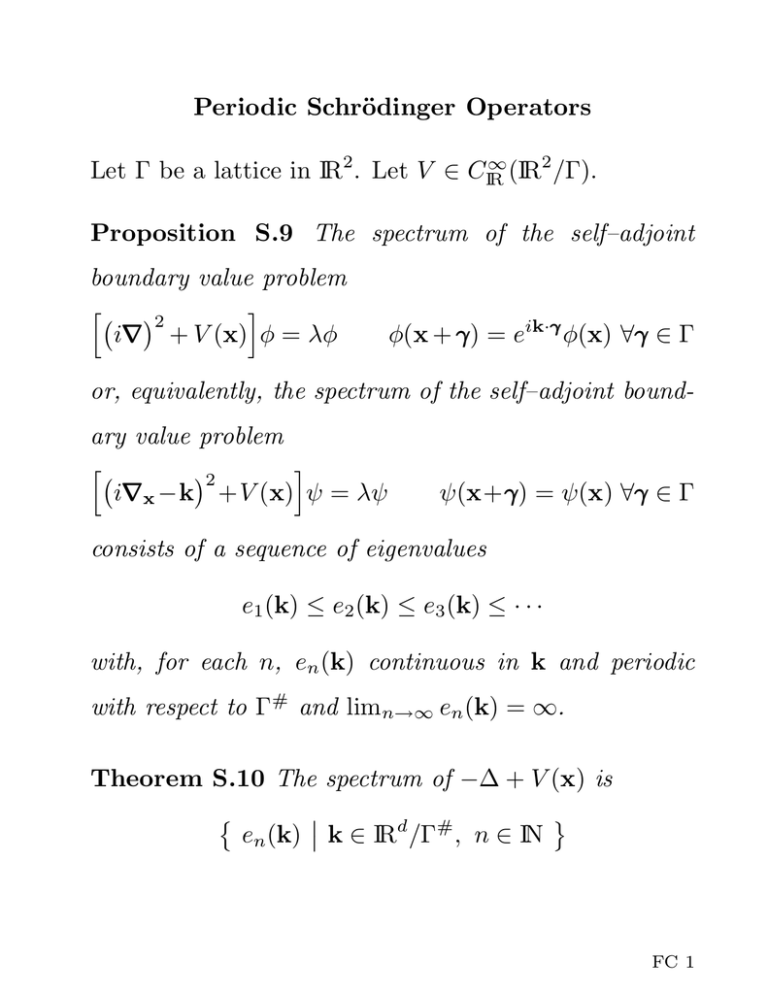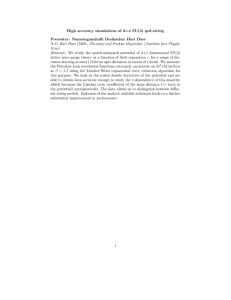Periodic Schr¨ odinger Operators Let Γ be a lattice in IR
advertisement

Periodic Schrödinger Operators
∞
(IR2 /Γ).
Let Γ be a lattice in IR2 . Let V ∈ CIR
Proposition S.9 The spectrum of the self–adjoint
boundary value problem
h
i
2
i∇
∇ + V (x) φ = λφ
φ(x + γ ) = eik·γγ φ(x) ∀γγ ∈ Γ
or, equivalently, the spectrum of the self–adjoint boundary value problem
h
i
2
i∇
∇x −k +V (x) ψ = λψ
ψ(x+γγ ) = ψ(x) ∀γγ ∈ Γ
consists of a sequence of eigenvalues
e1 (k) ≤ e2 (k) ≤ e3 (k) ≤ · · ·
with, for each n, en (k) continuous in k and periodic
with respect to Γ# and limn→∞ en (k) = ∞.
Theorem S.10 The spectrum of −∆ + V (x) is
d
#
en (k) k ∈ IR /Γ , n ∈ IN
FC 1
Fermi Curves Defined
The (real “lifted”) Fermi curve for energy λ is
k ∈ IR en (k) = λ for some n ∈ IN
2
2
= k ∈ IR
i∇
∇x − k + V (x) − λ ψ = 0
Fbλ,IR (V ) =
2
2
2
2
i∇
∇x − k + V (x) ψ = 0
k∈C
2
for some 0 6= ψ ∈ H (IR /Γ)
We may absorb the λ in V .
FbIR (V ) = Fb0,IR (V )
FIR (V ) = FbIR (V )/Γ#
The complexifications
Fb(V ) =
2
F(V ) = Fb(V )/Γ#
2
for some 0 6= ψ ∈ H (IR /Γ)
FC 2
The Free Fermi Curve
First set V = 0. Then
2
2
e
i x·b
b ∈ Γ#
2
is a basis of L (IR /Γ) of eigenfunctions of i∇
∇x − k .
2 i x·b
= (−b − k)2 ei x·b
i∇
∇x − k e
= Nb (k) ei x·b
= Nb,1 (k)Nb,2 (k) ei x·b
where Nb (k) = (k1 + b1 )2 + (k2 + b2 )2
Nb,ν (k) = (k1 + b1 ) + i(−1)ν (k2 + b2 )
Hence
2 #
b
F (V = 0) = k ∈ C ∃ b ∈ Γ with Nb (k) = 0
[
[
Nb =
Nb,ν
=
b∈Γ#
where
b∈Γ#
ν=1,2
2
2
Nb = k ∈ C (k1 + b1 ) + (k2 + b2 ) = 0
2 ν
Nb,ν = k ∈ C (k1 + b1 ) + i(−1) (k2 + b2 ) = 0
2
FC 3
−ik1
N0,2
N−b,2
Nb,1
Nb,2
N0,1
N−b,1
k2
Free Fermi Curve: Fb(V = 0)
FC 4
−ik1
k2
Free Fermi Curve: F(V = 0)
FC 5
Theorem. Let r > 1. There exists an entire function
F on C2 × Lr (IR2 /Γ) such that
2
ker i∇
∇x − k + V (x) 6= {0} ⇐⇒ F (k, V ) = 0
Idea of Proof.
Write
i∇
∇x − k
2
+ V (x) = 1l − ∆ + W (k, x) .
2
ker i∇
∇x − k + V (x) 6= {0}
⇐⇒ ker 1l − ∆ + W (k, x) 6= {0}
1
1
⇐⇒ ker 1l + √1l−∆ W (k, x) √1l−∆ 6= {0}
1
1
√
√
⇐⇒ det 1l + 1l−∆ W (k, x) 1l−∆ = 0
c =
Denote the eigenvalues of W
λi = λi (k, V ), i = 1, 2, 3, · · ·.
∞
X
|λi |
2r
<∞⇒
i=1
∞
Y
√ 1
√ 1
W
(k,
x)
,
1l−∆
1l−∆
P
1
Since
1+|n|2r < ∞
n∈ZZ2
(1 + λi )e
−λi + 12 λ2i
converges
i=1
Set
2
b
b
−tr W
+ 12 tr W
c
c)
F (k, V ) = lim det(1l + W )e
= det3 (1l + W
finite
rank
FC 6
“Theorem”. Outside of a compact set F(V ) is very
close to F(0) = Fb(0)/Γ# except that each
can open up to
z1 z2 = t
z1 z2 = 0
Generically all the double points open up and then we
have a Riemann surface (a one dimensional complex
manifold).
Idea of Proof. Fix any k. This k ∈ Fb(V ) iff there is
a nonzero ψ obeying ψ(x + γ ) = ψ(x) ∀γγ ∈ Γ and
h
i
2
i∇
∇x − k + V (x) ψ = 0
Expand ψ(x) =
to
2
P
(−b − k) ψ̃b +
c∈Γ#
X
(1)
ψ̃c eic·x . Then (1) is equivalent
Ṽ (b − c)ψ̃c = 0 ∀b ∈ Γ#
(2)
c∈Γ#
FC 7
Recall that
b+k
2
= Nb (k) = Nb,1 (k)Nb,2 (k)
where Nb,ν (k) = (k1 + b1 ) + i(−1)ν (k2 + b2 )
Nb (k) vanishes on Nb =
Nb (k) = 0 . Fix
k∈C
2
small and define the (-)tube about Nb by
Then
Tb = T1 (b) ∪ T2 (b)
2 Tν (b) = k ∈ C |Nb,ν (k)| <
k∈
/ Tb
=⇒
|Nb (k)| ≥
1+|Im k|1−
|Im k|
1 + |Im k|1−
and
• T b ∩ T b0 is compact whenever b 6= b0
• T ν (b) ∩ T ν (b0 ) = ∅ if b 6= b0
• T b ∩ T b0 ∩ T b00 = ∅ for all distinct b, b0 , b00 in Γ]
FC 8
−ik1
T2 (0)
T2 (b)
T2 (−b)
T1 (b)
T1 (0)
T1 (−b)
k2
FC 8a
To study the part of F̂ (V ) in the intersection of ∪d∈B Td
and C2 \ ∪b6∈B Tb for some finite subset B of Γ] it is
natural to split (2)
Nb (k)ψ̃b +
P
Ṽ (b − c)ψ̃c = 0 ∀b ∈ B
(2B )
Ṽ (b − c)ψ̃c = 0 ∀b ∈ B 0
(2B0 )
c∈Γ#
Nb (k)ψ̃b +
P
c∈Γ#
0
#
where B = Γ \ B. Set φ̃b =
Then (2B ) is
φ̃b +
P
c∈B 0
Ṽ (b−c)
Nc (k) φ̃c
Using
Mb,c
b,c∈B 0
≤ max
n
=−
P
Nb (k)ψ̃b
0
Ṽ (b − c)ψ̃c
if b ∈ B 0 .
if b ∈ B
∀b ∈ B 0
c∈B
o
P
P Mb,c Mb,c , sup
sup
c∈B 0 b∈B 0
b∈B 0 c∈B 0
one can easily see that, for k in the region under con
Ṽ (b−c) sideration,
Nc (k) b,c∈B 0 1.
FC 9
Hence Rb,c
b,c∈B 0
Ṽ (b−c)
Nc (k)
, with Rb,c = δb,c +
bounded inverse and
P
−1
0
φ̃b = −
Rb,d
0 Ṽ (d − c)ψ̃c
has a
∀b ∈ B 0
c∈B
d0 ∈B 0
or ψ̃c0 = −
P
c∈B
d0 ∈B 0
−1
1
R
0 ,d0 Ṽ
c
Nc0 (k)
(d0 − c)ψ̃c
∀c0 ∈ B 0
Substituting this into (2B ) yields, for all b ∈ B,
Nb (k)ψ̃b +
P
Ṽ (b − c)ψ̃c
c∈B
P
−
c∈B
c0 ,d0 ∈B 0
Ṽ (b−c0 ) −1
Nc0 (k) Rc0 ,d0 Ṽ
(d0 − c)ψ̃c = 0
This has a nontrivial solution if and only if the |B|×|B|
determinant
h
det Nb (k)δb,c + Ṽ (b − c) −
B
(k)
Sb,c
i
b,c∈B
=0
where
B
Sb,c
(k)
=
P
c0 ,d0 ∈B 0
Ṽ (b−c0 ) −1
Nc0 (k) Rc0 ,d0 Ṽ
(d0 − c)
FC 10
Proposition 19.5,6 Let k ∈ C2 with |Im k| > const .
a) Let k ∈ C2 \ ∪b Tb . Then k 6∈ F̂ (V ).
b) Let k ∈ T0 \ ∪b6=0 Tb . Then k ∈ F̂ (V ) if and only if
k2 = N0 (k) = A(k)
{0}
where A(k) = −Ṽ (0) + S0,0 (k) obeys
|A(k) + Ṽ (0)| ≤
∂ n+m
n m A(k) ≤
∂k ∂k
1
2
const
|Im k|2−
const
|Im k|
if m + n = 1
c) Let k ∈ T0 ∩ Td . Then k ∈ F̂ (V ) if and only if
N0 (k) + Ṽ (0)−D(k)1,1 Nd (k) + Ṽ (0)−D(k)2,2
= Ṽ (−d) − D(k)1,2 Ṽ (d) − D(k)2,1
where
{0,d}
D(k)i,j = Sdi ,dj (k),
d(1) = 0, d(2) = d
and obeys
|D(k)i,j | ≤
∂ n+m
n m D(k)i,j ≤
∂k ∂k
1
2
const
|Im k|2−
const
|Im k|
if m + n ≥ 1
FC 11
Theorem 19.9 Let V ∈ L2 (IR2 /Γ) with kbṼ (b)k1 < ∞.
Then F(V ) is a reduced one dimensional complex analytic variety, which consists of at most two components.
If F(V ) is smooth, then it is irreducible.
Theorem 20.2 Let q ∈ C ∞ (IR2 /Γ) be such that F(q)
is smooth. Then
reg
han
∪
F(q)
F(q) = F(q)com ∪ F(q)reg
2 ∪ F(q)
1
where
F(q)com = a compact Riemann surface with boundary
∼
F(q)reg
= C \ ({some disks} ∪ {compact})
1
∼
F(q)reg
= C \ ({some disks} ∪ {compact})
2
[
han ∼
F(q)
Yj
=
j≥g=1
Here g is the genus of F(q)com , Yj is biholomorphic to
2 z1 z2 = tj , |z1 |, |z2 | ≤ 1
(z1 , z2 ) ∈ C
CN
and, for all N , |tj | ≤ N for all j .
j
FC 12
Planar Parts of the Fermi Curve
FC 13
Interacting Fermi Curve: F(V )
FC 14






